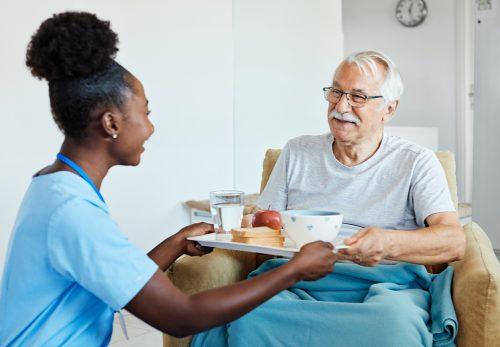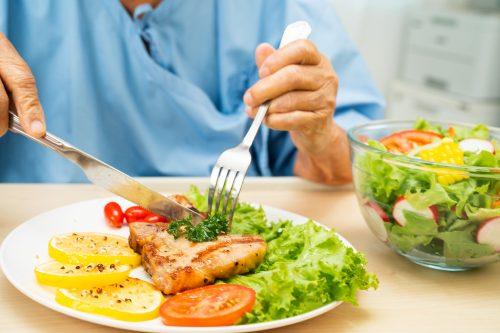When it comes to caring for seniors in long-term care, nutrition and hydration are more than just daily routines—they’re vital components of health, independence, and quality of life. According to a Commonwealth Fund’s report, studies have shown that 35% to 85% of U.S. nursing home residents are malnourished. While medications and therapies often get the spotlight, something as simple as a glass of water or a balanced meal can have a major impact on a senior’s well-being.
For healthcare providers, this means that nutrition and hydration aren’t just responsibilities—they’re opportunities to prevent illness, improve recovery, and enhance overall comfort for residents.
Why Nutrition and Hydration Matter So Much for Seniors in Long-Term Care
As people age, their nutritional needs change. Muscle mass decreases, metabolism slows, and appetite can decline. Add in chronic conditions like diabetes, heart disease, or dementia, and meeting those needs becomes even more critical. Hydration is just as important. Older adults often have a reduced sense of thirst, making them more vulnerable to dehydration. Even mild dehydration can cause confusion, dizziness, and an increased risk of falls—issues that can quickly escalate into serious health concerns.
Good nutrition and hydration can:
- Boost immune function
- Maintain muscle strength and mobility
- Support wound healing
- Improve mental clarity and mood
- Reduce hospitalizations and complications
For seniors in long-term care, these benefits can mean more independence, fewer medical interventions, and a better quality of life.
Common Challenges in Long-Term Care
While the goals are clear, delivering optimal nutrition and hydration in a long-term care setting can be challenging. Some common barriers include:
- Loss of Appetite – Many seniors experience changes in taste or smell, side effects from medication, or emotional factors like depression that reduce interest in food.
- Difficulty Swallowing (Dysphagia) – Conditions like stroke or Parkinson’s disease can make eating and drinking physically challenging.
- Cognitive Decline – Residents with dementia may forget to eat or drink, or may not recognize food.
- Special Diet Requirements – Some seniors need low-sodium, diabetic-friendly, or texture-modified diets, which require careful planning.
- Staffing Pressures – Busy schedules can make it hard for staff to closely monitor every resident’s intake.
Recognizing these barriers is the first step to overcoming them.
Practical Nutrition Strategies for Seniors in Care

Here are some evidence-based, practical strategies that healthcare providers can implement in their daily routines:
Offer Smaller, More Frequent Meals
Instead of three large meals a day, try offering smaller portions more often. This can be less overwhelming for residents with smaller appetites and help keep their energy levels stable.
Prioritize Protein
Protein helps maintain muscle strength and supports healing. Include lean meats, fish, eggs, beans, or dairy in each meal. For residents who struggle to chew, try softer options like yogurt, cottage cheese, or pureed meats.
Enhance Flavor Naturally
If a resident’s sense of taste is diminished, avoid overloading meals with salt or sugar. Instead, use herbs, spices, and natural flavor enhancers like lemon juice or garlic.
Address Special Diet Needs Without Sacrificing Appeal
Texture-modified diets can still be visually appealing. Use molds or piping bags to shape pureed foods so they look like their original form. Presentation can greatly improve appetite.
Make Snacks Nutritious
Offer nutrient-dense snacks between meals, such as smoothies, trail mix, cheese cubes, or fortified puddings.
Hydration: More Than Just Water
Keeping seniors in long-term care hydrated is a daily challenge, especially if they rarely feel thirsty. Here’s how to make it easier:
Offer a Variety of Drinks
Water is essential, but some residents may prefer tea, flavored water, or diluted fruit juice. Offer both hot and cold options to suit personal preferences.
Use Foods with High Water Content
Fruits like watermelon and oranges, soups, and gelatin desserts all contribute to fluid intake.
Make Drinks Accessible
Place drinks within reach and encourage sipping throughout the day rather than just at mealtimes.
Track Intake
Use simple tracking sheets to monitor daily fluid intake and spot patterns before dehydration becomes a problem.
Recognizing the Warning Signs
Early detection of malnutrition or dehydration can prevent serious complications. Look for:
Signs of Malnutrition:
- Unplanned weight loss
- Fatigue or weakness
- Slow wound healing
- Changes in skin or hair condition
Signs of Dehydration:
- Dry mouth or cracked lips
- Dark urine or reduced urination
- Confusion or irritability
- Dizziness, especially when standing
If these signs appear, prompt action—such as consulting with a dietitian or adjusting the care plan—can make a big difference.
Creating a Supportive Mealtime Environment
Sometimes it’s not the food or drink itself but the environment that affects a resident’s willingness to eat or drink.
- Reduce Distractions: Keep the dining area calm and free of loud noises or constant interruptions.
- Encourage Social Dining: Mealtime is also a chance for social interaction, which can stimulate appetite.
- Offer Gentle Assistance: For residents who need help, offer it discreetly so they can maintain dignity.
Teamwork Makes the Difference
Nutrition and hydration are team responsibilities. Nurses, aides, dietitians, kitchen staff, and even families all play a role. Regular communication between these groups ensures that changes in a resident’s appetite, health status, or diet needs are addressed quickly. Training staff on the importance of nutrition and hydration—and equipping them with practical tools—can significantly improve resident outcomes.
The Bottom Line

For seniors in long-term care, nutrition and hydration are foundational to health, comfort, and dignity. They are not “extra” services but essential components of care. By making small, consistent improvements—whether it’s offering an extra snack, adjusting food textures, or encouraging sips of water throughout the day—healthcare providers can have a lasting, positive impact.
Every bite and every sip matters.
Call to Action for Healthcare Providers
By strengthening your team’s skills, you’re not only ensuring compliance—you’re streamlining daily routines, boosting efficiency, and building trust with residents and their families.
Let’s make that happen together. Enroll your large team in our customized, free course development program today and create a care environment where every sip and every bite supports dignity, health, and hope. Click here.



